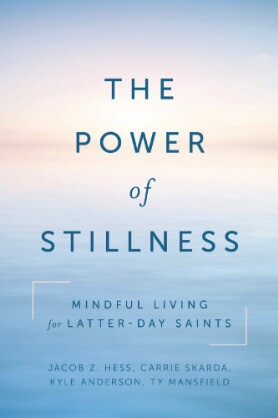Scholar Adam Miller writes: “The Sabbath is God’s way of interrupting our lives. It’s his way of interrupting time, of breaking its spell. With the Sabbath, God introduces a hiccup into time, a beat of stillness, a little pocket of eternity.”
Like God Himself, we can “bring the world to an end every seven days,” as Miller puts it, and use the Sabbath to celebrate the end of our own work.
Creating still spaces on the Sabbath to savor our relationships with God and our loved ones takes intention and practice. After one especially exhausting Sunday, one of our families decided to start protecting the day more—trying to make it more of a legitimate retreat:
Alongside various smaller adjustments like stepping away from email, news, and social media, we looked for ways to block off more time for just sitting together and talking or reading—even opting out of some of the family gatherings so we could have a little more space. The result was new refreshment flowing from the Sabbath—far more than we had experienced previously.
Sometimes the way we begin the day can set the tone. In response to the common pattern of waking up too late, rushing with baths and getting kids dressed, and trying to get out the door to (hopefully!) make it to church on time, we’ve experimented with building more stillness into the morning routine as a way to set a different tone. After specifically waking up earlier for some early morning time to pray and meditate, we’ve found that having kid-free time to commune more intimately with God leaves us feeling more filled rather than rushed in the morning. We’ve also been intentional about waking up kids a little earlier to allow for a slower-paced morning, thus creating a Sabbath energy that ripples throughout the day.
Brother Mark de St. Aubin similarly writes about adopting a practice with his wife of “taking time on Sunday to be silent with one another—turning off even music and allowing our home to be a silent place for a few hours.” He reflects:
When we can do this, it feels like we are fasting from the usual chatter and junk food that the world and our own monkey mind provides in order to enjoy instead a quiet oasis from sound, communication, and chatter. It allows for my mental digestive system to come to a place of rest and feels like the kind of welcomed renewal for which the Sabbath was intentionally designed.
What could discovering deeper Sabbath rest mean for your own life? If you move in this direction, don’t be surprised if you get hit with worries about “being unproductive” or “wasting time” that could otherwise be put toward accomplishing something else. That’s normal for anyone trying to make more space. Resist those voices! Something beautiful lies beyond them.
This is something different from pursuing “vacation time” or finding some way to entertain ourselves. As Christian author Henri Nouwen writes:
We say to each other that we need some solitude in our lives. What we really are thinking of, however, is a time and place for ourselves in which we are not bothered by other people, can think our own thoughts, express our own complaints, and do our own thing, whatever it may be. . . . But that is not the solitude of John the Baptist [and other ancient disciples]. For them solitude is not a private therapeutic place. Rather, it is the place of conversion, the place where the old self dies and the new self is born, the place where the emergence of the new man and the new woman occurs.6
Wrestling the Kids
While the idea of the Sabbath as a retreat may sound inspiring, as anyone with children knows, there are sometimes special ninja moves required even just to get through church! Like many families, ours have often taken for granted that kids need “something to do” during church. Despite an abundance of crayons, books, and snacks, however, the kids in one of our families were so irritable and noisy in sacrament meeting one Sunday that we started wondering whether the very things designed to occupy them in church were having an opposite effect: reinforcing distraction and inattention.
So we tried an experiment:
What would happen if we didn’t bring all the extra stimulation to church with us? All of a sudden, we saw our children sitting. Uncomfortably—obviously wanting the distractions back—but slowly learning to be okay without constant stimulation, getting better and better at resting in stillness.
Sometimes, of course, the kids just won’t settle, and that’s part of the practice too. After one challenging Sunday, Carrie wrote:
Kids. Interrupt. Every. Two. Seconds. They don’t care if you’re sick, if you’re busy, if you’ve got an important deadline, if you’re really in the flow of what you are doing . . . they do not care. And they definitely don’t care that the sacrament is supposed to be Mom’s quiet meditation time with Jesus. But meditation is not about uninterrupted laser focus. It’s a cyclical process of getting distracted, catching the distraction, and coming back to awareness—which helps me not lose my mind during the sacrament: “Mom, the Cheerios fell all over the floor.” (Okay, full disclosure, Fruit Loops.) “Mom, make me a paper airplane.” “Mom, I want to sit next to you, Kevin won’t let me sit next to you, scoot OVER, KEVIN!” “Mom, Dad is asleep.” “Mom, why did Jesus die anyway?”
Of course, this kind of distractibility is not limited to just the kids!
Sunday Worship as Sitting Practice
We’ve all experienced it: sitting in church, listening to the speaker—and having our mind wander. Don’t we sometimes assume that our obligation is simply to soldier on, trying to do our duty—even though it’s hard and, well, “I’m not getting much out of this.” We may also get irritated about our boredom or critical of the speaker . . .
Other times, of course, we simply catch our drifting mind and bring our attention back to the speaker, doing our best to listen some more—until the attention wanders again.
Interestingly enough, this is one of the core skills taught in formal mindfulness training. Rather than somehow getting the mind to stop, it’s about noticing when your attention has wandered and then gently, compassionately escorting the mind back to an anchor point—usually the breath or body (in this case, the speaker). Then repeat.
Physical sensations in the breath or body as a whole aren’t necessarily “exciting” either—but they don’t need to be in order to anchor mindfulness practice. And Latter-day Saint worship, with its simple, unadorned operations, provides another great opportunity for intensive, regular mindfulness practice (more so, in fact, than if it were dramatically entertaining). Christian leader Parisa Parsa notes, “Church services are one of the last places left to gather for non-commercial reasons not centered on entertainment.”
Again and again, we can bring our attention back to the talk, the words of a prayer, and the music. The placement of hymns right before prayer creates a unique opportunity to steady and calm our minds for what comes next.
Rather than being only spectators, of course, everyone has the chance to share, be heard, and grow among the Saints. That means we all get practice listening to common people who are often unpolished, and we learn to hold a loving, forgiving space for each other as brothers and sisters.
In a recent combined priesthood meeting, one of us walked in to find 35 men in rapt attention to the speaker:
Not a single cell phone was out. These men who could have been watching football at home were all listening carefully to another plain-spoken brother counseling them on how to become better husbands and fathers. I had a clear sense that I was witnessing something remarkable.
We’ve also noticed a difference in our conversations at church when we approach the interaction as an opportunity to practice meditation, with the “anchor” being the person with whom we’re speaking.
When we bring a full, calm presence to the small interactions with our brothers and sisters, whether shaking hands and catching up or coordinating administrative logistics, we find ourselves better connecting with people, even though the words exchanged are no different from before.
These are things we practice every week as members of the Church: quiet presence and compassionate attention.
Our Most Precious Mindful Practice
Similar to Christians the world over, we join in a very simple practice that Jesus Himself taught all His followers: bringing our hearts and minds together to focus attention for a short period of time on an ordinary piece of bread and a small drink of water.
In this moment we renew not only our individual covenants with God but our collective sense of unity with one another as His covenant people. More than just a nice little ritual, this mindful practice is described by the Lord as “a commandment” that He pleads with us to “always do” (3 Nephi 18:12). President David O. McKay taught, “The short period of administering the sacrament is one of the best opportunities we have for . . . meditation”—in particular, a chance to “meditate upon his goodness.”
Fighting for a Little More Space the Rest of Our Week
In all these ways, the Sabbath can become a regular retreat to rest our hearts and minds deeply. What about the rest of our week? As prophets have encouraged for many years, our experience has been that even little steps toward more silence and stillness—retreating just a bit from the hustle on a daily basis—can be life-changing.
It was Jesus who encouraged people to intentionally get away from the rush of life to be with God: “Enter into thy closet, and when thou hast shut thy door, pray to thy Father . . . in secret” (Matthew 6:6). Sometimes finding space takes fighting for it a little—pushing back on the colonization of our minds and hearts by foreign distractions or aggressive demands, kind of like boxing out for a rebound in basketball.
C. S. Lewis taught: “The real problem of the Christian life comes where people do not usually look for it. It comes the very moment you wake up each morning. All your wishes and hopes for the day rush at you like wild animals. And the first job each morning consists simply in shoving them all back; in listening to that other voice, taking that other point of view, letting that other larger, stronger, quieter life come flowing in.” He adds, “We can only do it for moments at first. But from those moments the new sort of life will be spreading through our system: because now we are letting Him work at the right part of us.”
Do you know what that feels like—to wake in the morning to a sense of demands and deadlines so tangible that you feel them in your gut? Next time that happens, see what it’s like to push back a little and find some space to breathe.
For some, the best time to reground is first thing in the morning, while others find this deeper stillness in pauses during the day or in the lull before bedtime. The exact time may be unique to our body’s rhythms and life circumstances, but when we consecrate a piece of our “best time of day” to the Lord, He can touch that time, like He did the few loaves and fishes, and create a soul-nourishing bounty beyond what we would expect in mere minutes.
Learn about other ways you can bring more peace into every part of your life by reading the brand-new book Power of Stillness: Mindful Living for Latter-day Saints by Jacob Z. Hess, Carrie L. Skarda, Kyle D. Anderson, and Ty R. Mansfield, available at Deseret Book stores and on deseretbook.com.




